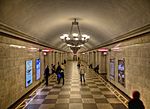Vladimirskaya Church

Our Lady of Vladimir Church (Russian: Владимирская церковь) is a Russian Orthodox church, dedicated to Our Lady of Vladimir and located at 20 Vladimirsky Prospect, St. Petersburg, Russia. The avenue takes its name from the church. The current five-domed church was built next to Vladimirsky Market between 1761 and 1769. The church's design, frequently ascribed to Pietro Antonio Trezzini, straddles the line between Baroque and Neoclassicism. The building has two stories, with the lower church dedicated to Saint John Damascene. The detached belfry is a fine work of mature Neoclassicism, built to Quarenghi's design in 1791. The portico, chapel, fence, and outbuildings were added in the 19th century. The interior of the church features an elaborate Baroque iconostasis, transferred from the Anichkov Palace chapel in 1808. When the 900th anniversary of the Christianisation of Russia was celebrated in 1888, the church underwent restoration. The most famous of its parishioners was Fyodor Dostoevsky. The church was closed in 1932, restored to the Russian Orthodox Church in 1989 and named a cathedral in 2000. It gives its name to the Vladimirsky Avenue and Vladimirskaya Square. The church is accessible by the station Vladimirskaya of Line 1 of the Saint Petersburg Metro and the station Dostoyevskaya of Line 4.
Excerpt from the Wikipedia article Vladimirskaya Church (License: CC BY-SA 3.0, Authors, Images).Vladimirskaya Church
Vladimirskiy Prospekt, Saint Petersburg
Geographical coordinates (GPS) Address Website External links Nearby Places Show on map
Geographical coordinates (GPS)
| Latitude | Longitude |
|---|---|
| N 59.9282 ° | E 30.3484 ° |
Address
Собор Владимирской иконы Божией Матери (Владимирский собор)
Vladimirskiy Prospekt 20
191102 Saint Petersburg (Владимирский округ)
Saint Petersburg, Russia
Open on Google Maps











